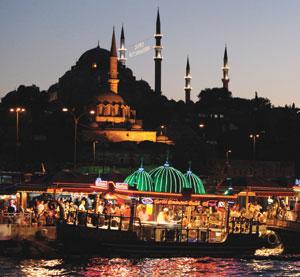The Dervish House by Ian McDonald (Gollancz)

Istanbul is known as the “Queen of Cities”, but she is more. During February, the Guardian published two stories focusing on her paradoxes and contradictions. One was headlined “Minarets and martinis”; the other focused on the pull – eloquently portrayed by Turkish novelist Orhan Pamuk — between the old “(which is usually local and Islamic) and the new (generally Western and secular)”. The newspaper dubbed Istanbul “a world in itself consisting of countless villages.”
That imagery of microcosm and macrocosm haunts Ian McDonald’s new novel, The Dervish House, set in the city in 2027. It recurs in imagery, from the pervasive presence of nanotechnology to the exquisite micro-graphy of an Islamic manuscript, images composed of letters, themselves composed of letters so tiny they have become pixels.
In previous novels about Brazil and India, McDonald has forced us to see with the perspectives of societies not our own. Unlike the utopian science fictions that assume progress inexorably turns other societies Western, he paints futures in which the non-Western co-opts progress to its own purposes. In 2027 Istanbul, it is the Nano Bazaar not the Grand Bazaar that is magic.
“This is dangerous like the true magic always is. This is the new terminus of the Silk Road; central Asia’s engineers and nanoware programmers the merchants and caravan masters of the Third Industrial Revolution.”
Like those other McDonald books, The Dervish House shifts perspectives between half a dozen protagonists, from a faded old Greek economics professor to nouveau riche traders and shiny, ambitious graduates, Turkey’s equivalent (in name as well as kind) of Tom Wolfe’s Masters of the Universe. There’s a Da Vinci Code-style mystery involving the missing relic of the Mellified Man and two halves of a miniature Koran. There’s a fiery Islamic leader, whose street justice committee has genuine virtue as well as dogmatism. There are Kurds and Russians and people who sold out during the reign of Turkey’s colonels. There are several love affairs, one with money itself.
But whereas those shifting perspectives sometimes made the earlier books unsettling reading, here McDonald has borrowed from the conventions of contemporary Arabic fiction to find an anchoring metaphor in the Dervish House itself: home now not only to the spirits of dervishes, but also to the flesh of most of the main characters. As in Alaa Al-Aswany’s The Yacoubian Building or Naguib Mahfouz’s Palace Walk, the building, with its inherited memories and echoes of previous occupants, ties the narrative neatly, if intricately together.
In this textured and detailed book, whose jewelled and scented scenes almost lift off the page, tiny machines shift actions and relationships until the Queen of Cities finds a new order, her residents “mindless automata in their individuality, intelligent in society [in ways that] cannot be predicted from the behaviour of individual components”.
via Nanotech among the minarets – Friday – Mail & Guardian Online.

Leave a Reply